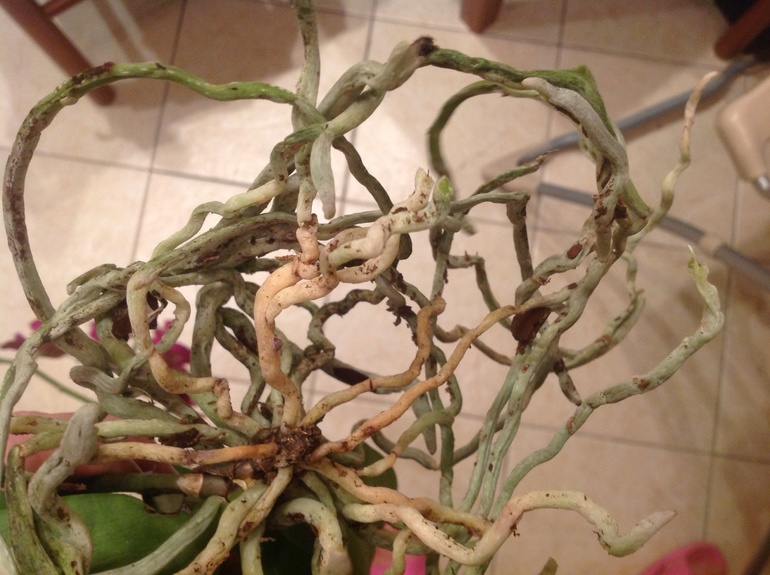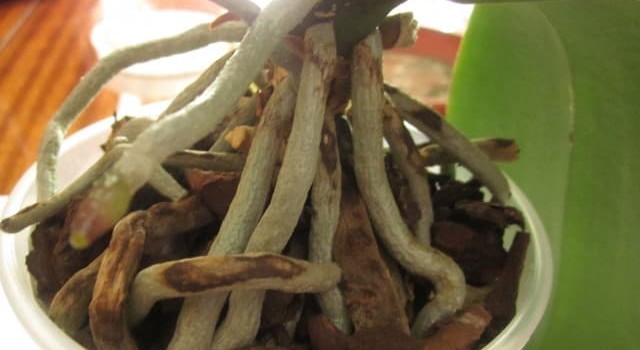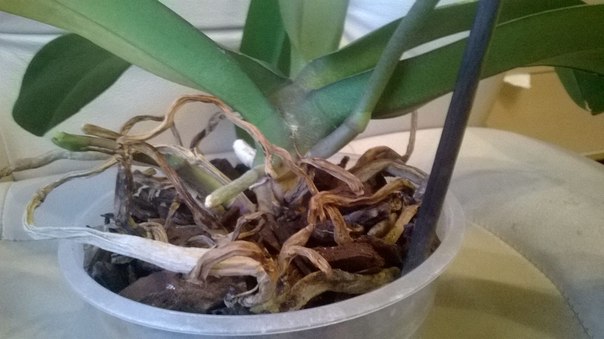
Orchids have one interesting feature that is not known to all lovers of exotic beauties. The condition of the underground organs is not always reflected in the appearance of the plant. Abundant flowering and vibrant greenery can be found in a flower with a partially dried root system and orchid roots dry shriveled. If timely measures are not taken, the orchid may soon die.
Causes of orchid roots dry shriveled
To understand what exactly is causing the problem, it is worth remembering the natural growing conditions of orchids. The homeland of the most beautiful species is the tropics with extreme humidity. Providing such a climate in an apartment or house is not easy. In addition, unlike most indoor flowers, the exotic beauty does not grow in the ground, but is attached to the branches and trunks of trees. Hence the main difficulties of leaving, which lead to damage to the root system:
- Insufficient moisture. With a slight degree of its shortage, drying of the aerial roots is noted. Although this does not affect the appearance of the orchid, it lacks some of the nutrients, which reduces flowering and lengthens the period of bud formation.
Another common occurrence is improper irrigation technology. The flower grower, following the rule, do not pour water into the orchid outlet, moistens the soil only around the perimeter of the pot. As a result, the central part of the roots may dry out. To prevent this from happening, the flower is watered from a watering can, directing the stream to the base of the growth and slightly lifting the leaves.
- Excess water. Many orchid enthusiasts over-water in an attempt to maintain high levels of humidity. The abundance of moisture is fraught with more serious problems – the root atrophies, gradually the plant begins to rot, fungal plaque and infections appear, which will soon infect other indoor flowers.
Along with inappropriate humidity, other care errors can also cause the roots of an orchid to dry:
- improperly selected pot (lack of space leads to the interlacing of roots and the gradual displacement of old layering with new ones, as a result of which the root dries up in places); here is our guide on Best Orchid Pots for Phalaenopsis growing and reporting.
- inappropriate temperature conditions and changes are prerequisites for the development of diseases, the drying roots of an orchid become private signs;
- poor-quality soil leads to a deterioration in the aeration of the roots, and also hinders the access of nutrients, as a result of which the underground part dries out (it must necessarily include 1/3 of moss, 1/3 of a mix of charcoal and bark plus perlite); here is solution for its Best Growing Medium for orchids.
- watering and spraying with too hard water (so that the orchid does not dry out, the water must be boiled and defended before use);
- improperly selected fertilizer – an excess of nitrogen, phosphorus, potassium and other minerals causes a chemical burn of the roots, as a result of which they lose their ability to absorb water, necessary trace elements and dry out.
Having found one or two dry roots on an orchid, you should not immediately start to panic, it does not dry out. If the whole indoor flower is beautiful and elastic, the reason for the appearance of suspicious areas may be associated with the aging process of the roots. In this case, there is a natural renewal of obsolete organs. This process is not dangerous for the pet.
Symptoms of unhealthy orchid roots

Partial root death in an orchid may be normal. Therefore, it is necessary to be able to distinguish the line between it and the problem. It is worth paying attention to the following signs:
- Number of ground roots. A harmoniously developing orchid will never release more than 4 of them. If a pot of a suitable size is braided with a network of air vents, this is evidence that the underground part is drying out and urgent rescue measures need to be taken.
- Branching roots indicate a lack of watering. Ignoring this sign will lead to the fact that they fill the entire pot, interfering with the normal functioning of the central root outlet, the orchid will slowly dry.
- In parallel with drying of the roots, yellowing of the foliage, loss of elasticity, and the appearance of spots are noted. This fact indicates a lack of nutrients or an onset of illness. A detailed study of the symptoms will help identify the problem.
- Rapid death of the peduncle. Under optimal conditions, in phalaenopsis, it remains fresh for up to six months (new green arrows form from the faded shoots). In other members of the genus, this period is much shorter – 1-2 months. However, if the roots of the orchid dry out, the peduncle begins to wither after a couple of weeks.
When one or more of the listed signs appear, the orchid may still exist for more than one year. According to statistics, more often its death is caused by pests or diseases, for which dry roots are a favorable environment for distribution. The complicated situation will give out additional manifestations – the appearance of spots on the leaf, its complete or partial drying out, poor flowering. Therefore, as soon as the thought came that something was wrong with the orchid, it is better to immediately take emergency measures to save the flower.
How to fix Orchid roots shriveling?
If the roots of the orchid have time to dry thoroughly, you do not need to immediately throw out the plants (the chances of saving it remain great). Resuscitation includes a classic set of actions that begins with a transplant:

- The first step is to carefully remove the orchid from the old pot. The process is complicated by the fact that the root system grows into the drain holes, and can also dry out to the walls, which makes it impossible to get the flower without damage. That is why orchids are recommended to be planted in transparent plastic pots, which, if necessary, can be easily cut with scissors. When the plexus can be removed, try to straighten the underground part and remove the remaining substrate. It is also important that in natural conditions the roots of an orchid need access to air and light.
- Assess the extent of the damage. Often, upon detailed examination, it turns out that under the accumulation of dry fragments, the orchid has quite healthy roots. The main indicator of their status is color. A pronounced gray or silver shade is a sign of moisture deficiency. However, such parts can still be reanimated, so you should not cut them off. Another thing is if the spine has acquired a brown or yellow color – in this case it cannot be saved, pruning is shown.
If it is difficult to visually determine the condition of the root, you can slightly crush it with your hands. A viable specimen will at least partially retain its elasticity, and a dead one will crumble.
- Mark the shriveled, dry roots with a marker. They have already given up all the nutrients of the greenery, and cannot be restored.
- Remove the discovered dry roots, and sanitize the cut. For this, powdered activated charcoal or special bactericidal preparations for indoor plants (Fitosporin-M, ecogel Agricola, systemic fungicide Fundazol and other compounds) are suitable.
- Immerse the ground part in warm water and let it stand in it for a little over an hour.
- Place the orchid in a clean pot of new soil and discard the old one. Reusing the substrate is prohibited, because it managed to accumulate a harmful substance (amines and other decomposition products).
After transplanting, you do not need to immediately start watering. The renewed soil contains a small amount of moisture by default. In addition, the treated plant should dry out slightly. Therefore, watering is resumed after 1 week.
At first glance, sad things may happen to the orchid – the aerial root system will dry out. In reality, this indicates that the process of restoration of the main underground part has begun, and the associated wilting is a natural reaction to the presence of fragments, the need for which has disappeared. Depending on the severity of the damage, the period of complete rehabilitation of the orchid will take from 2 weeks to six months.If the plant had to cut off all the roots, then planting in the ground is contraindicated until strong 6-centimeter roots appear. In this case, the orchid is first fixed on wet moss, and when the situation permits, they are transferred to a permanent place.
Additional care for orchids roots
A slight drying process can be stopped by conservative methods. Special feeding will help to solve the problem. This is an effective way to save the roots located inside the pot, which are difficult to reach mechanically. To care for an orchid, ready-made liquid dressings specially developed for this plant variety (Agricola, Forte, Rea Sil, Royal Mix and other brands) are suitable.
You can prepare effective formulations yourself. To do this, it is enough to take a teaspoon of honey, glucose and sugar, and then dilute them in 1 liter of settled water. Such watering will provide the roots of the orchid with the nutrients necessary in a stressful situation.
After pruning the underground part of the flower, the Epin growth regulator gives good results. It is enough to dilute one drop of the drug in 1 liter of water and water the plant with it. The action of the components is aimed at stimulating root growth, so the recovery of the orchid will accelerate.Growth stimulants (store and home) are used no more than 1 time in 2 months. Otherwise, excessive growth of the root system will begin, its thinning, and as an extreme case, the orchid will begin to rot.
Water softening: How to fix a dehydrated orchid?
If the reason that the orchid is drying is due to the use of poor water for irrigation, the following trick will help to revive it. Pour a small pinch of oxalic acid into a five-liter bottle and add water. After a day, the solution is filtered and watering is carried out.
You can remove excess hardness from the water using wood ash or peat. One 10-liter bucket takes 30 and 100 g of components. In the resulting composition, you need to soak a sluggish and dry flower (its underground part). He should stay in it for 1.5-2 hours. Then let the orchid dry completely. The procedure must be repeated until the damage is completely restored.
If there is no time to do the manipulations recommended above, and there are no signs that the plant needs to be urgently rescued, it is enough to use purified water for irrigation. To do this, it is driven through a regular kitchen filter and allowed to stand at room temperature for a day.
How to prevent orchid roots from drying
So that the orchids does not start to dry out, you need to provide the main condition for growth. The optimal temperature regime. In summer, the thermometer should not rise above 28 degrees, and in winter it should drop below 16 degrees. A list of what should be done to prevent the roots of the orchid from drying out:
- provide diffused lighting (install additional lighting in the autumn-winter period); here our complete guide on Growing Phalaenopsis Orchids under Lights.
- replant the orchid as the roots grow and renew the substrate at least once every 3 years (this will prevent the growth of bacteria and reduce the risk of infection of the orchid);
- additionally spray the air root from the spray bottle when the room is too dry (especially during the heating season);
- do not allow air to stagnate in the apartment, but remember that drafts are detrimental to the orchid;
- provide a difference between day and night temperatures (but not more than 5 degrees);
- with increased dryness of the air, put a cup of water next to the flower or place the pot on a damp tray filled with expanded clay;
- normalize the watering system (on average, orchid roots need one moisture per week).
You can visually determine its need by the presence of condensation on the inner wall of the pot with the orchid. If droplets are still present in the roots, the flower still has enough water.
If the preventive work on the care of the orchid is carried out in compliance with the listed requirements, the probability that the air and underground roots will begin to dry is excluded.
Novice florists, having seen an impressive list of everything necessary for an exotic guest, believe that the flower is capricious and not suitable for growing in apartments. There is some truth in this. However, the markets and shops mainly sell hybrid varieties that have managed to adapt to new climatic conditions. With proper care and proper moisture levels, the orchid will delight the owner with lush blooms and healthy greenery for many years.
